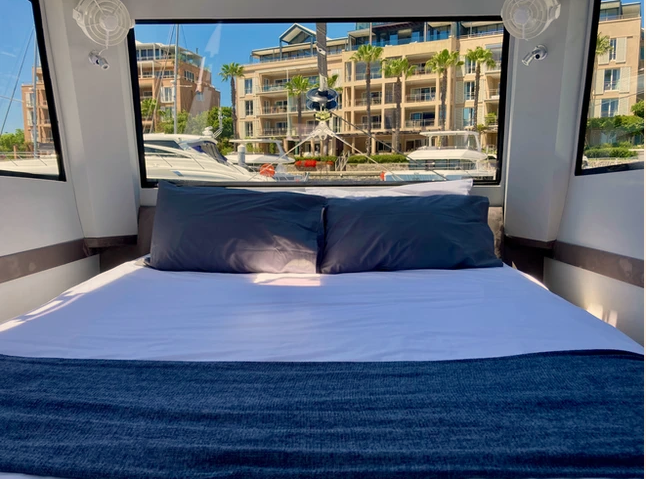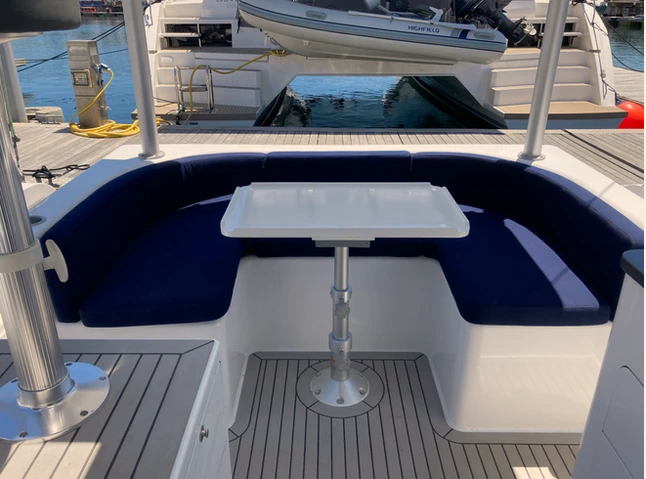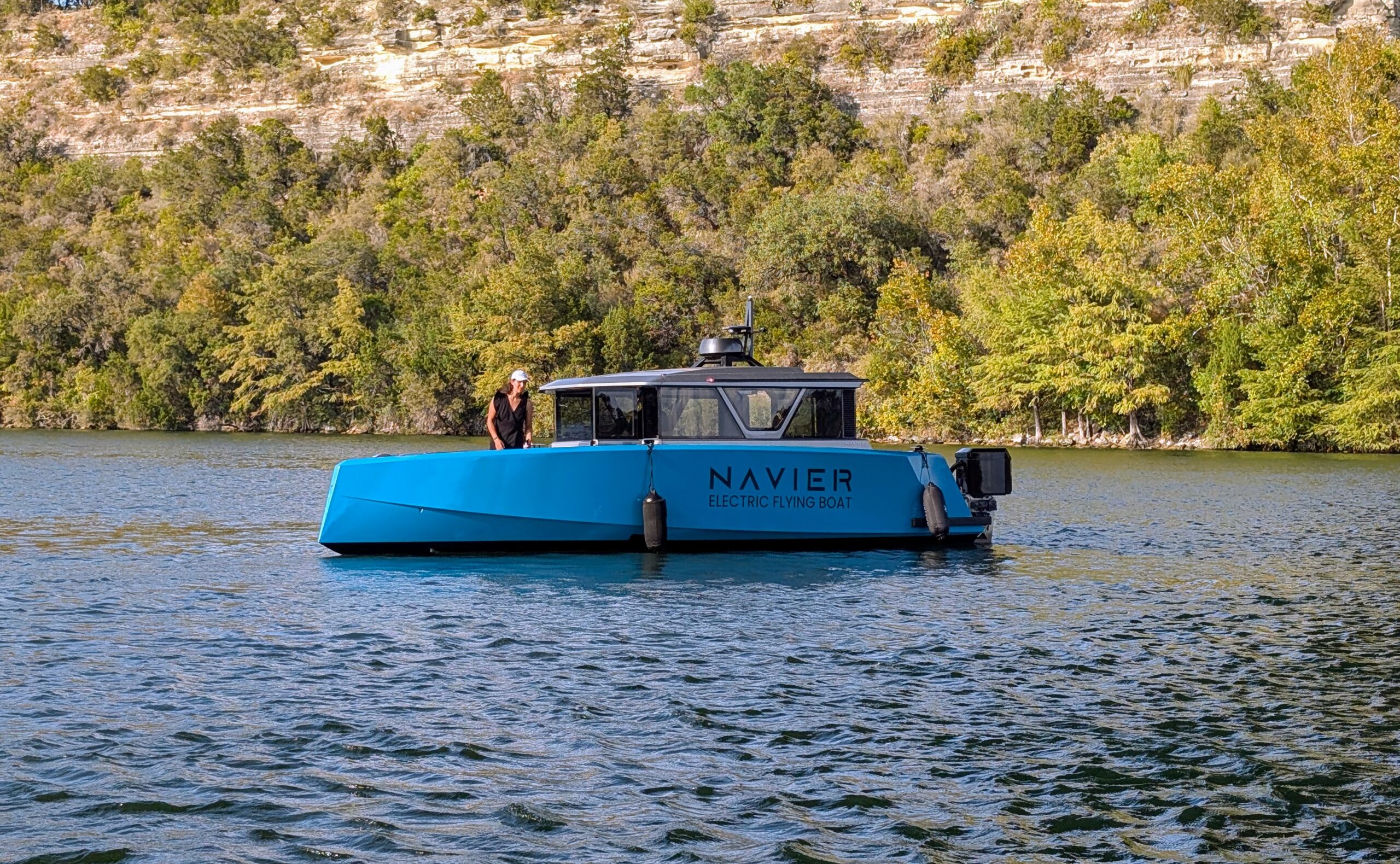Sign up for daily news updates from CleanTechnica on email. Or follow us on Google News!
At CleanTechnica, we have written a number of articles about a variety of fully electric boats. These vessels are mostly for outdoor recreation and are sometimes called pleasure- or leisure-craft. In no particular order, they are the Voltari 260, X-Shore Eelex 8000, Blue Innovation Group R30, and Candela C-8. They tend to be powerful and fast.
Recently on YouTube, another kind of electric boat caught my attention: the HopYacht. This one differs from the others in that it has solar power and sail power in order to use sunlight and wind. The HopYacht is also a catamaran, not a monohull. Another difference is that it emphasizes efficiency and longer distance trips rather than speed. At full throttle, it reaches 6.9 knots per hour; the cruising speed is 4.2 knots. At cruising speed it can travel for over 8 hours, not including electricity generated by the solar panels, provided there is adequate sunlight. The HopYacht uses much smaller electric motors and batteries.
Here are some of the specifications:
- Two 6 kW (9.9 hp) electric Pod Drives
- Two 14.4 kWh Lithium Ferro Phosphate Batteries
- 1,600 watts of solar power capacity
- Twin rudders
- Length: 30.68 feet
- Width: 11.29 feet, maximum
- Displacement: 6,834 lb
- Sail area: 323 square feet
- Mast height: 32.81 feet
- Price: $215,000, ready to sail
The vessel is appropriate for overnight trips for a couple or a couple with small children. There is a private cabin with a full-sized bed and a saloon with a table, and seating that folds down to make another bed. The galley has two induction hobs for cooking, and there is a 60 liter fridge/freezer onboard.
In fact, the eye-catching YouTube video features a HopYacht traveling over 200 miles in the Greek Islands in 10 days. They started at Piraeus and ended at Preveza, covering slightly more than 200 nautical miles while only using shore power twice to charge.
In the journey’s first leg, from Piraeus to Isthmia, they traveled 33.8 nautical miles (NM) starting at 8 am and finishing at 4:45 pm. This leg of the journey started with a 100% charge and ended with 71%. During the trip they used these propulsion modes: electric motors, wind power combined with electric motors, and wind power only. Only one stage during the entire journey was greater than the 33.8 NM day: Nafpaktos to Ormos Oxia, which was 38.7 NM. On this stage, they hit a top speed of 7.3 knots per hour using wind only. The shortest stage covered 8.7 NM; the rest were in between 8.7 NM and 38.7 NM. In the video it is stated they could have covered the total distance traveled over the 10 days in just five. What is particularly noteworthy is that on some days they ended their travels with slightly more battery charge than when they started, but did not recharge with shore power. Though 1,600 watts of solar power is not a lot, it did a good job charging the two batteries as the vessel moved through the Greek waters.
I reached out to HopYacht and received a prompt reply, “Paul and Mary-Clare Tomes founded HopYacht in 2021, spent many years chartering yachts in different parts of the world, especially in the Mediterranean. They discovered that sailors on holiday, or simply setting off for a day or two of coastal or bay hopping, behaved differently.”
Paul commented that, “once clear of the moorings, these sailors tended to only unfurl the genoa and rarely hoisted the mainsail. Boat speed for most people wasn’t as much of a priority as keeping life on board easy going.”
With small electric motors only, wind only, or combining the two to achieve a reasonable cruising speed with virtually no noise and no fumes from gas or diesel-powered engines, one could understand the appeal of moving through the Mediterranean in this way. Especially cruising easily through the Greek islands or off the coasts of Italy, France or Spain…it sounds like a delightful way to travel and experience what you could not on land only.
He added, “Another huge advantage of electric propulsion is that it can get you out of trouble fast! For example, stalling a boat whilst tacking in close proximity to another boat or a harbour wall could spell disaster. In the time needed to start a diesel engine, engage the gear lever and get the revs up, you could already have hit something. Electric propulsion is available instantly … on demand.”
One of the exciting aspects of a sailing vessel that also has electric motors, solar power, and batteries is the potential for off-grid self-sufficiency, meaning that in favorable conditions — adequate wind and sunlight — sailors might be able to travel for weeks or months without needing to charge from shore power. With such a potential ability, one would be able to hang out and sail through the Greek islands in more remote areas if that was your interest.
In one of their blog posts, HopYacht explained they put the boat’s propulsion, clean energy, and electrical systems to the test, “At the end of each day of sea-trials and test sails with prospective clients, when we return to our marina berth, we have deliberately left the boat unplugged!”
“Our all-electric HopYacht 30 has been off the grid now for over 2 months, relying on the solar panels to recharge the batteries. The fridge freezer and other systems run 24 hours a day. Actually, we have yet to unwrap the shore power cable and the marina berth we currently occupy doesn’t even have an electrical supply!”
At that time, their location was Cape Town, South Africa, and they acknowledged the weather then was mostly sunny, with some overcast moments.
Another potential is for add-on generation from an accessory wind turbine to generate a light or trickle charge when anchored at leisure or at night with adequate wind when there is no sunlight for solar charging.
For the more mechanically inclined and intrepid, there might be an option to craft a custom temporary rack to add another solar panel or two or arrange some portable solar panels like the ones from Renogy. As with adding a small wind turbine, the additional electricity generated from an extra solar panel or two wouldn’t be that significant, but it would help a little for longer passages, again, with adequate sunlight.
For the price, the HopYacht is surely one of the most interesting electric boats. For comparison, and it isn’t exactly an apples-to-apples example, let’s look at a popular conventional catamaran that isn’t all electric and can’t run only on solar power — the Lagoon 38. A used one runs anywhere from $150,000 up to about $350,000 or more. It was discontinued and replaced by the Lagoon 40, which costs approximately over $400,000 new. (A Dragonfly 32 trimaran costs over $300,000 new.)
The HopYacht provides an affordable, quiet, slower, relaxing vessel for island hopping and coastal cruising without using gasoline or diesel fuel, which sounds intriguing for people who love tooling around the Mediterranean or the Caribbean and don’t have a need for speed.
Have a tip for CleanTechnica? Want to advertise? Want to suggest a guest for our CleanTech Talk podcast? Contact us here.
EV Obsession Daily!
I don’t like paywalls. You don’t like paywalls. Who likes paywalls? Here at CleanTechnica, we implemented a limited paywall for a while, but it always felt wrong — and it was always tough to decide what we should put behind there. In theory, your most exclusive and best content goes behind a paywall. But then fewer people read it!! So, we’ve decided to completely nix paywalls here at CleanTechnica. But…
Thank you!
Community Solar Benefits & Growth
CleanTechnica uses affiliate links. See our policy here.






